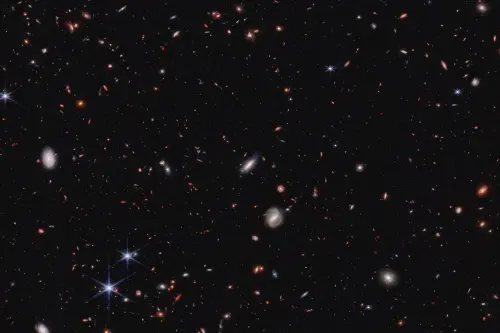
Observations of the early universe made by NASA's flagship James Webb Space Telescope are challenging the traditional theory of gravity and how the first galaxies formed.
This is the conclusion of a new study by astrophysicist Stacy McGaugh—of Ohio's Case Western Reserve University—and his colleagues.
According to the team, the standard model of early galaxy formation predicted that, staring at the distant (and therefore, given how light takes time to travel, young) universe, Webb should have seen only dim signals from small and primitive galaxies 13 billion years ago, when the universe was less than half-a-billion years old.
"The expectation was that every big galaxy we see in the nearby universe would have started from these itty-bitty pieces," McGaugh said in a statement.
What astronomers have observed instead, however, is that these early galaxies are large and bright—meaning something is amiss in our understanding of the universe's evolution.
The largest and most powerful space telescope ever built, Webb's infrared instruments are capable of seeing objects so distant the light from them takes up to 13.5 billion years to reach us, effectively providing a window back into the infancy of the universe.
This has allowed us to see, for the first time, how the first stars and galaxies formed — and test the hypothesis that invisible "dark matter" helped normal matter clump together bit by bit, building up increasingly large structures until galaxies formed.
"Astronomers invented dark matter to explain how you get from a very smooth early universe to big galaxies with lots of empty space between them that we see today," said McGaugh.
However, he said: "What the theory of dark matter predicted is not what we see."
The large, bright signals that Webb keeps seeing, even as it looks deeper and deeper into the universe's past, are, however, compatible with another theory: Modified Newtonian Dynamics, or "MOND", for short.
"If MOND is indeed the correct theory—the status we usually confer to theories that get so many a priori predictions right—then the broader implications are enormous," McGaugh told Newsweek.
"For one, it implies that we have been barking up the wrong tree with dark matter. The reason we haven't detected dark matter in the laboratory despite decades of dedicated searches is because it is not there."
"The discrepancies we attribute to invisible dark matter are in fact due to a change in the force law. That in turn implies that our theory of gravity is incomplete."
Filling in these potential gaps, McGaugh added, will require a "major change in thinking" of the likes physics hasn't seen since the development of quantum mechanics a century ago.
The standard cosmological model invokes invisible dark matter to explain why galaxies appear to spin faster than they should based on what they can be seen to contain.
In MOND, meanwhile, this discrepancy is explained away by suggesting that Newton's law of gravity breaks down in situations where the pull of gravity is very weak—such as, for example, in the outer regions of galaxies.
Models suggest that in a MOND universe, cosmic structures like burgeoning galaxies would be built up much faster—first expanding outward with the rest of the universe, before collapsing in on itself under a stronger force of gravity to form a galaxy.
This would produce the same large and bright structures seen now by Webb, proponents of MOND first argued more than 25 years ago.
"The bottom line is: 'I told you so'," said McGaugh. He added: "I was raised to think that saying that was rude, but that's the whole point of the scientific method: make predictions and then check which come true."
Do you have a tip on a science story that Newsweek should be covering? Do you have a question about space? Let us know via [email protected].
Reference
McGaugh, S. S., Schombert, J. M., Lelli, F., & Franck, J. (2024). Accelerated Structure Formation: the Early Emergence of Massive Galaxies and Clusters of Galaxies. The Astrophysical Journal. https://doi.org/10.3847/1538-4357/ad834d
Related Articles
- Video Shows Dramatic Fireball Over US As SpaceX Starlink Satellite Reenters
- 2024's Final Supermoon: When Best To See It
- Leonid Meteor Shower 2024: How To Watch It Peak Next Week
- Almost Everything We Know About Planet Uranus May Be Wrong
